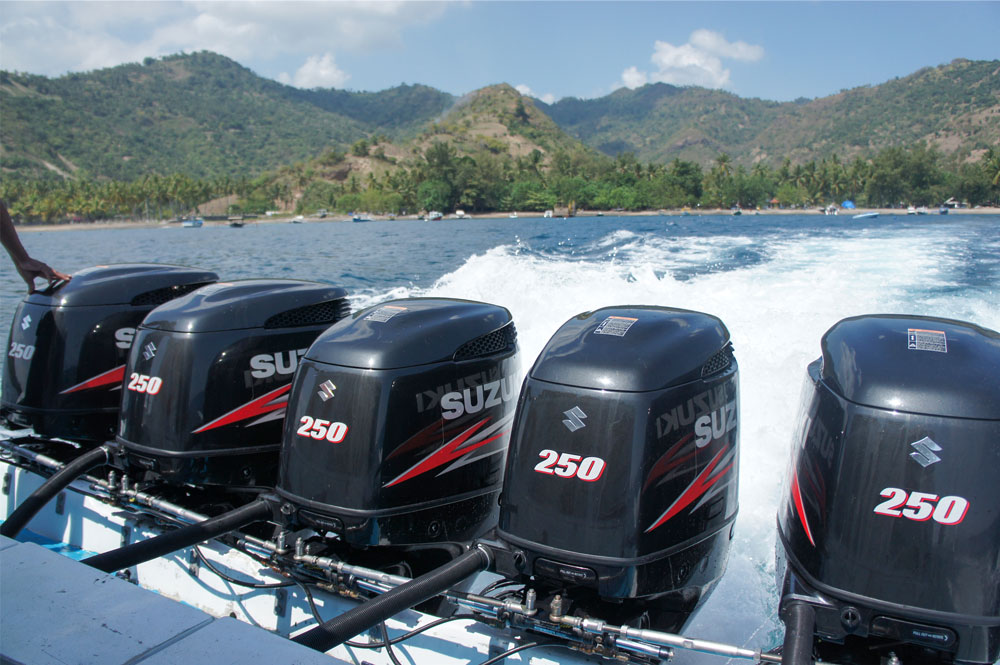how to select the right size hp outboard motor for your boat
Choosing the right size HP outboard motor is crucial for your boat’s performance. It ensures safety and efficiency on the water.
A motor that’s too small may struggle, while one that’s too large can be dangerous.
Understanding the relationship between your boat’s size, weight, and motor power is key.
This guide will help you navigate the complexities of selecting the perfect outboard motor.
From calculating horsepower to considering boat type, we cover all the essentials.
Why Outboard Motor Size Matters
The size of your outboard motor impacts your boat’s overall performance and safety. A mismatched motor can lead to inefficient operation or even accidents.
Underpowering your boat can cause sluggish performance, making it harder to navigate choppy waters. An overpowered motor may put too much strain on the boat, risking structural damage.
Selecting the correct motor size is vital for maximizing fuel efficiency. A well-matched motor uses less fuel, which saves money and benefits the environment.
Consider these points when choosing motor size:
- Boat’s length and weight
- Typical number of passengers and load
- Intended use: leisure, fishing, or watersports
Each aspect plays a role in finding the optimal motor size.
Selecting the right motor size ensures your boat performs at its best. It also protects your investment and enhances your boating experience.
Key Factors in Choosing the Right HP Outboard Motor
Selecting the right horsepower (HP) for your outboard motor is key to achieving optimal boat performance. Several factors play into this critical decision-making process.
One fundamental aspect is the boat’s size and design. Longer, heavier boats typically require more HP for efficient movement and control.
Another factor is your intended use. Different activities demand different power levels. Watersports may need higher HP for speed, while fishing might not.
Load capacity is also important. Consider the typical number of passengers and equipment you plan to carry. A fully loaded boat will need more power.
Hull type can influence motor choice. Planing hulls need higher speeds to lift out of the water, needing more HP than displacement hulls.
Here are key considerations:
- Boat’s length and weight
- Intended activities (fishing, cruising, etc.)
- Typical load (passengers and gear)
- Hull design
Selecting a motor with the right power ensures efficiency and safety.
A qualified marine professional can provide valuable insights. Consulting them can help make the most informed choice.
Understanding Boat Size, Weight, and HP Requirements
Grasping the connection between your boat’s size, weight, and HP needs is essential. A mismatch can lead to inefficient performance or even unsafe boating conditions.
Large boats generally require more horsepower. This ensures they can cruise smoothly and handle additional weight from passengers or equipment.
On the other hand, smaller boats often need less power. Overpowering can make handling tricky and might increase fuel consumption unnecessarily.
Weight impacts how much power you need. Heavier boats typically need more horsepower to move at desired speeds and perform well under various conditions.
Key factors to consider include:
- Boat’s total weight (including passengers and gear)
- Desired cruising speed
- Specific boating activities
- Water conditions you’ll encounter
Remember, it’s not just about being powerful—balance and control matter too. Achieving the right balance ensures a safe and enjoyable experience on the water. Consulting a marine expert is a smart step in this crucial decision-making process.
How to Calculate the Ideal Horsepower for Your Boat
Determining the right horsepower for your boat involves considering several important factors. Start by checking your boat’s capacity plate for the maximum HP rating.
This plate provides critical information about your boat’s limits. It typically includes weight and passenger capacity, along with the recommended horsepower.
Another calculation method involves using the formula: Boat Weight ÷ 25 = Minimum HP. This gives a base idea of horsepower needs.
However, remember these points:
- Maximum HP ensures optimal performance.
- Consider extra weight from passengers and equipment.
- Adjust for specific activities like watersports that demand more power.
Once you’ve grasped these basics, you can refine your choice by considering your boating habits. Regular boating conditions, whether smooth lakes or choppy seas, also influence horsepower decisions. For peace of mind, seek advice from a marine professional for tailored recommendations.
By calculating with care, you ensure your boat’s motor offers both efficiency and safety, making every journey pleasant and worry-free.
Outboard Motor Sizes and Typical Applications
Choosing the right outboard motor size depends greatly on how you plan to use your boat. Different sizes cater to varied boating activities and conditions.
For small fishing boats or leisure crafts, motors less than 20 HP are usually sufficient. They offer adequate power for calm lakes and modest currents.
Medium-sized outboard motors, ranging from 20 to 75 HP, are ideal for larger fishing vessels or family boats. They provide a balance of power and fuel efficiency.
Finally, consider high-performance motors exceeding 75 HP for activities like water skiing or for large boats. These motors ensure speed and power for demanding maneuvers.
Here’s a quick guide to motor sizes and uses:
- Under 20 HP: Small crafts, calm waters
- 20-75 HP: Medium boats, mixed-use
- Over 75 HP: Large boats, high-speed activities

Selecting the right motor size enhances your boating experience. Match the motor to your specific needs to achieve the best performance on the water.
Using an HP Comparison Chart
An HP comparison chart is a valuable tool for boat owners. It helps in evaluating different outboard motor sizes efficiently.
These charts provide a side-by-side view of motor specifications. You can quickly identify which motor fits your boat’s needs.
With a comparison chart, assessing features such as weight, power output, and fuel efficiency becomes straightforward. Review the options to make an informed decision.
Key elements in an HP comparison chart might include:
- Horsepower range
- Weight specifications
- Maximum speed potential
- Fuel economy ratings
Using a chart streamlines the motor selection process. It empowers you with detailed insights at a glance.
The Impact of Underpowering or Overpowering Your Boat
Choosing the wrong motor size can affect performance. Underpowering your boat results in sluggish handling and poor response times. It’s important to match the motor to your boat’s needs.
Overpowering, on the other hand, risks safety and control. It can cause excessive wear and tear on the hull. You might lose stability in rough waters.
To avoid these issues, consider these factors:
- Manufacturer’s HP rating
- Boat’s intended use
- Weight capacity and distribution

Both underpowering and overpowering have downsides. Understanding their impacts ensures safe boating. Ensure the motor fits your boat’s specifications perfectly.
Two-Stroke vs. Four-Stroke Outboard Motors
Choosing between two-stroke and four-stroke motors can be challenging. Each has distinct advantages and trade-offs. Your choice depends on your boating goals and preferences.
Two-stroke motors are often lighter and deliver quick acceleration. They are a favorite for sports and high-speed needs. However, they can be less fuel-efficient.
Four-stroke motors are known for quieter operation and reduced emissions. These motors are more fuel-efficient and environmentally friendly. Consider these factors when selecting:
- Weight and portability
- Fuel efficiency
- Emission levels

Selecting the right stroke type enhances your boating experience. Balance your preferences with performance needs for optimal results.
Additional Considerations: Fuel Efficiency, Maintenance, and Regulations
Fuel efficiency is crucial for boating economy. Choosing a motor that optimizes fuel use saves money and reduces environmental impact. Efficient motors mean fewer trips for fuel, letting you explore longer.
Proper maintenance extends your motor’s lifespan. Regular inspections and timely servicing can prevent breakdowns. Follow the manufacturer’s guidelines to keep your motor in top condition.
Regulations ensure safe and legal boating experiences. Adhering to local laws regarding motor size and emissions is vital. Check these points to ensure compliance:
- Local and federal boating regulations
- Emission standards and limits
- Scheduled maintenance requirements

Balancing these considerations will enhance performance and safety. Making informed decisions ensures a better, more sustainable boating adventure.
Where to Find Outboard Motors for Sale and What to Look For
Finding the right outboard motor starts with reliable sellers. Visit Water Sports House
known marine stores or check reputable online marketplaces. Ensure the seller’s credibility through reviews and ratings before proceeding.
When searching, be clear about your priorities. Determine if you value horsepower, brand reputation, or price most. Assess product features against your boating needs and budget.
Consider these points when evaluating options:
- Availability of warranty and after-sales service
- Compatibility with your boat’s systems
- Seller’s return and exchange policies

A well-chosen motor will enhance your boating experience. Doing diligent research helps you secure an ideal match for your boat.
Tips for Testing and Selecting Your Outboard Motor
Testing is key to selecting the right outboard motor. Always conduct a test drive, if possible. This provides firsthand experience of performance and noise levels.
During tests, observe the motor’s responsiveness. Pay attention to how swiftly it reaches maximum speed. Evaluate vibrations and handling under different conditions.
When testing, consider:
- Smoothness of starting and stopping
- Noise levels at various speeds
- Fuel efficiency in actual use
Choose a motor that aligns with your boating needs. Prioritize efficiency, reliability, and overall experience. Your choice should enhance your time on the water.
Conclusion: Making the Best Choice for Your Boating Needs
Selecting the right outboard motor is crucial for a satisfying boating experience. Consider all factors such as size, weight, and intended use to ensure you make the best choice. Evaluate horsepower needs in relation to your boat’s capacity and your activities.
Don’t underestimate the role of maintenance and fuel efficiency. These factors impact the long-term cost and performance of your motor. A higher upfront investment can save money over time in fuel and repairs.
Lastly, involve experts when needed. Consult with marine professionals and use reviews and community insights to guide your decision. With thorough research and consideration, you can find an outboard motor tailored to your needs. Enjoy the peace of mind knowing you’ve made an informed, beneficial choice for your boating adventures.












